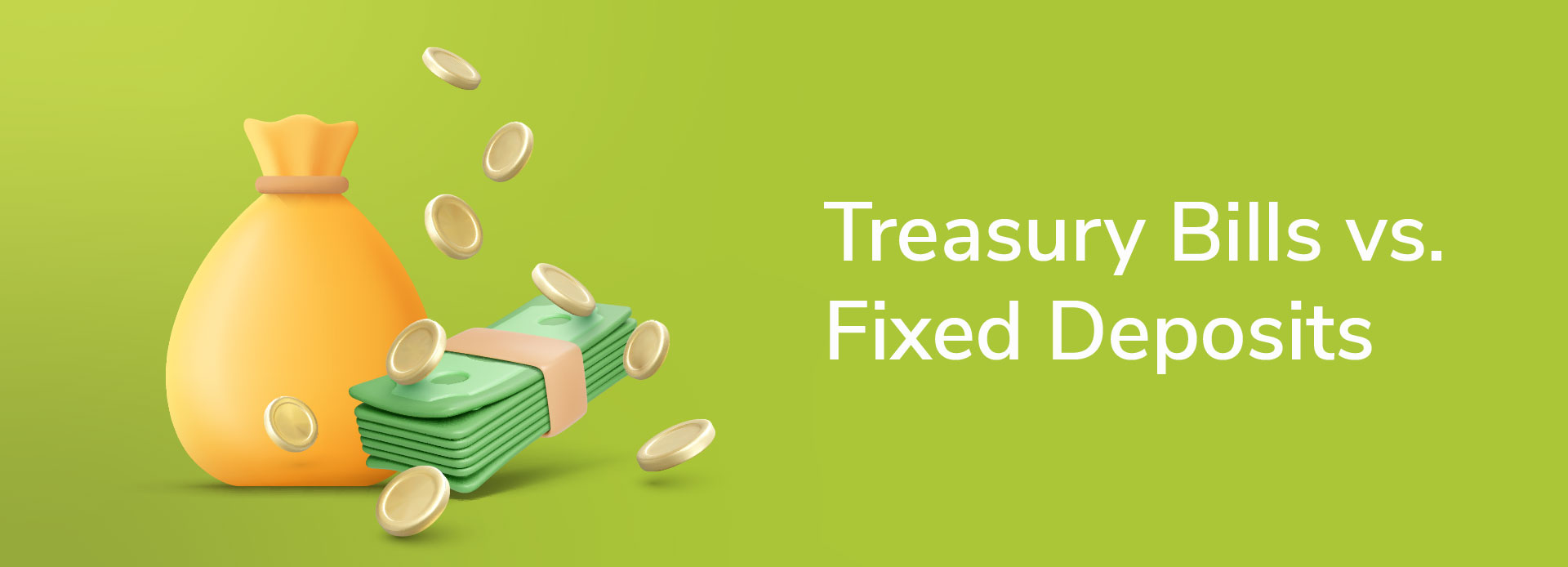
Treasury Bills vs Fixed Deposits: Which One Should You Consider?
27 April 2024 | By INDIE
Did you know that Indians invest approximately ₹60 trillion every year? Alongside real estate, Treasury Bills and Fixed Deposits (FDs) are highly popular among investors. This is because both offer safety and stable returns while serving distinct investment purposes. In this article, we'll delve into the key differences between Treasury Bills and FDs, helping you select the option that best suits your risk and investment objectives.
Understanding Treasury Bills:
Treasury Bills or T-Bills, are short-term debt instruments issued by the Reserve Bank of India (RBI) on behalf of the Government of India. These instruments serve to meet the government's short-term financial requirements and are considered among the safest investment options due to government backing.
Types of Treasury Bills:
Treasury Bills come in four types based on their maturity periods: 14, 91, 182, and 364 days. Each type has its own auction frequency and minimum investment amount, as summarised in the table below:
Maturity Period |
Auction Frequency |
Minimum Investment Amount |
14 Days |
Every Wednesday |
₹1 Lakh |
91 Days |
Every Week |
₹25,000 |
182 Days |
Every Other Week |
₹25,000 |
364 Days |
Every Other Week |
₹25,000 |
Understanding Fixed Deposit:
Fixed Deposits, or FDs, are investment options offered by banks and financial institutions. They allow investors to deposit a sum of money for a fixed period at a predetermined interest rate. FD, also known as time or term deposits, provide a steady income with relatively low risk.
Comparison: Treasury Bill vs. Fixed Deposit
1. Profitability in terms of interest:
Fixed Deposits, often offered by banks and financial institutions, provide a regular interest income. However, compared to Treasury Bills, their returns may seem relatively modest. For instance, the average interest rate for FD interest rates ranges from 4% to 7% per annum, while Treasury Bills issued by governments typically offer higher interest rates, often exceeding 7.5% per annum.
2. Flexibility in Withdrawing Funds:
One aspect where Treasury Bills shine is liquidity. Unlike Fixed Deposits, which often come with penalties for premature withdrawals, Treasury Bills can be easily liquidated during government auctions. This flexibility allows investors to access their funds without significant penalties, making T-bills a more liquid option than FDs.
3. Risk-factor and Credibility:
While both Fixed Deposits and Treasury Bills are considered low-risk investments, there are subtle differences in their risk profiles. Treasury Bills are backed by the government, making them less risky. On the other hand, while Fixed Deposits are generally safe, they are subject to the stability of the financial institution offering them.
4. Tax Benefits and Service Fees:
One notable advantage of Treasury Bills is their tax-exempt status, allowing investors to maximise their returns. In contrast, interest earned from Fixed Deposits is subject to taxation. For example, interest income from FDs exceeding Rs. 10,000 (for individuals) and Rs. 50,000 (for senior citizens) is taxable annually. Additionally, while Treasury Bills may involve minimal fees, Fixed Deposit might incur service charges or penalties, impacting the net returns for investors.
Read more on tax-saving FDs - Tax saving FD for section 80C deductions: Benefits, interest rates, risks, and limits
Here’s a side-by-side comparison of t bills vs fd for better understanding:
Characteristics |
Treasury Bills |
Fixed Deposits |
Return |
Guaranteed but lower compared to FDs |
Higher FD interest rates, subject to variation |
Risk |
Low, backed by government |
Higher, backed by financial institutions |
Liquidity |
High, can be converted or sold in secondary market |
Premature withdrawal possible with penalties |
Tenure |
Short-term, ranging from 14 to 364 days |
Flexible, from 7 days to 10 years |
Minimum Investment |
Generally higher |
Lower |
Taxation |
Lower taxation obligation, not subject to TDS |
Taxed based on income tax slab |
Interest Rate Fluctuation |
Interest rate remains stagnant throughout tenure |
Interest rates may vary based on market conditions |
Withdrawal |
Can be withdrawn at government auctions |
Premature withdrawal possible, with penalties |
So, Which Option Should You Consider?
In conclusion, while Treasury Bills may offer enticing returns and easier liquidity in the short run, Fixed Deposits provide a sturdy foundation of stability and reliability over extended periods. Therefore, your decision ultimately relies on aligning key factors such as risk tolerance, investment horizon, and financial goals.
Ultimately, both Fixed Deposits and Treasury Bills serve as valuable components within a diversified investment portfolio.





